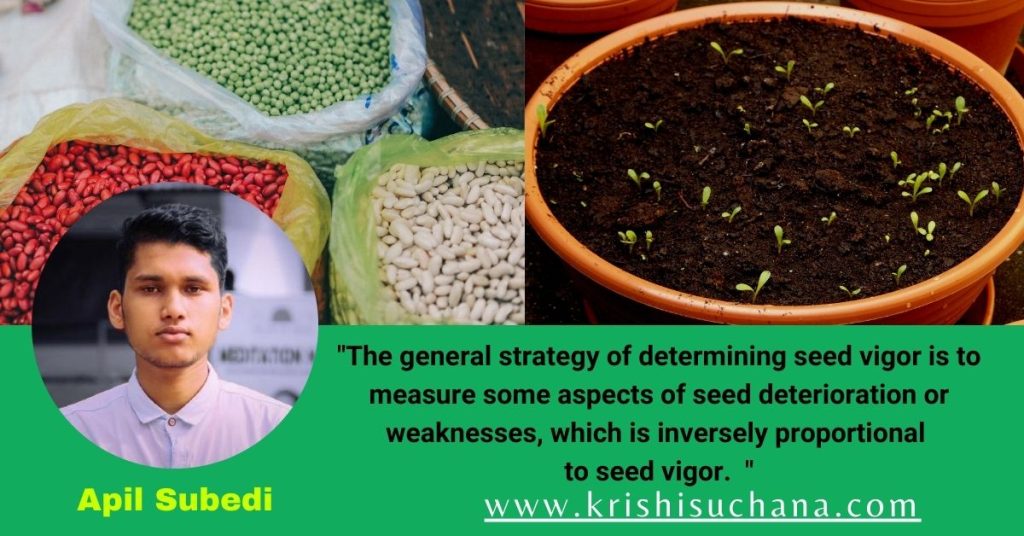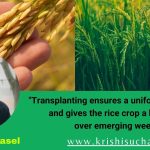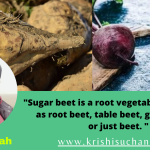What is seed vigour? Its role in seedling establishment

The sum total of those properties of the seed which determine the level of activity and performance of the seed or seed lot during germination and seedling emergence. Seeds are central to crop production, human nutrition, and food security. A key component of the performance of crop seeds is the complex trait of seed vigour. Crop yield and resource use efficiency depend on successful plant establishment in the field, and it is the vigour of seeds that defines their ability to germinate and establish seedlings rapidly, uniformly, and robustly across diverse environmental conditions. Improving vigour to enhance the critical and yield-defining stage of crop establishment remains a primary objective of the agricultural industry and the seed/breeding companies that support it. Our knowledge of the regulation of seed germination has developed greatly in recent times, yet understanding of the basis of variation in vigour and therefore seed performance during the establishment of crops remains limited. Probably no other component of seed quality has been the subject of as much controversy and misunderstanding as seed vigour. Although the complex underlying mechanisms of seed vigour have not been fully described, much progress has been made in our understanding of the phenomenon and its practical consequences. This first of two articles on seed vigour and seed vigour testing summarizes our current understanding of this seed property
As the germination test is conducted in an optimum condition specific to different species, it is not always possible to get an idea of the performance of a seed lot in the field on the basis of germination test in the laboratory. It is mainly because of the reason that field conditions are seldom optimum and the emerging seeding suffers from one or the other kind of stress. In many cases, seed lots having similar laboratory germinations may give widely differing field emergence values. Similarly. Two seed lots having the same germination percentage in the laboratory may give differently when stored under ambient condition. These two situations indicate the incompetences of germination test in assessing the performance of a seed lot in the field or storage. This offers scope and possibility to determine the vigour of a seed lot so that its field and storage performance can be assessed.
Seed vigour is still a concept rather than a specific property of a seed or seed. Several factors like; genetic constitution, environment and nutrition of mother plant. Maturity at harvest, seed weight and size, mechanical integrity, deterioration and ageing and pathogens are known to influence seed vigour (Perry, 1984a). Therefore, care has to be exercised in selecting a seed vigour test to do the job. Two criteria have been employed by the ISTA seed vigour committee to evaluate, the performance of seed vigour test methods for different crops:
Methods of measuring seed vigor
The general strategy of determining seed vigor is to measure some aspects of seed deterioration or weaknesses, which is inversely proportional to seed vigor.
Cold test, accelerated ageing test, electric conductivity test, seedling vigor classification, and seedling growth rate are among the tests that are used to measure seed vigor. In addition, the tetrazolium (TZ test) can be used as a vigor test by classifying the pattern of stained seeds into high, medium and low quality. The AOSA Seed Vigor Testing Handbook is a good source of information on seed vigor testing. Below is a brief description for some of the most common seed vigor tests that are used for various crops including corn, soybean, field beans, peas, grasses, vegetable seeds, and other crops.
COLD TEST (CT)
The cold test simulates early spring field conditions by germinating the seeds in wet soils (»70% water holding capacity) and incubating them at 5-10°C/41-51°F for a specified period. At the end of the cold period, the test is transferred to a favorable temperature for germination (e.g., 25°C/77°F in case of sweet corn). The percentage of normal seedlings is considered as an indication of seed vigor. Vigorous seeds germinate better under cold environments.
When can the cold test be used?
ACCELERATED AGING TEST (AAT)
The principle of this test is to stress seeds with high temperatures of (40-45°C/130-139°F) and near 100% relative humidity (RH) for varying lengths of time, depending on the kind of seeds, after which a germination test is made. High vigor seeds are expected to tolerate high temperatures and humidity and retain their capability to produce normal seedlings in the germination test.
When can the AAT test be used?
ELECTRIC CONDUCTIVITY TEST
This test measures the integrity of cell membranes, which is correlated with seed vigor. It is well established that this test is useful for garden beans and peas. It has been also reported that the conductivity test results are significantly correlated with field emergence for corn, and soybean. As seeds lose vigor, nutrients exude from their membranes, and so low quality seeds leak electrolytes such as amino acids, organic acids while high quality seeds contains their nutrients within well structured membranes. Therefore, seeds with higher conductivity measurement are indication of low quality seeds as vice versa.
Importance of seed vigour:
Injury from thrips is exacerbated by any factor that slows seedling growth. Reduced growth rates of seedlings allow thrips to feed on developing terminal leaves for a longer period of time and also prolong the time between seedling emergence and the 4-5 leaf stage (point at which seedlings are generally safe from thrips) which intensifies the adverse effects on yield and maturity. With the loss of aldicarb, there is a greater need to promote rapid seedling growth to minimize these losses, through planting high-vigor seed and planting in warm, moist soils when conditions following planting are expected to favor vigorous growth. This is especially important in modern times as many of our thrips control products may expire before seedling reach the thrips “safe stage” if growth is slowed too much. Secondly, as we all know, the success of modern weed control programs relies heavily on effective use of residual herbicides to prevent pigweed emergence. An occasional side effect of such is herbicide injury, which can also slow seedling growth and most commonly occurs when experiencing rainfall at cracking or when seedlings imbibe a high concentration of herbicide as they are trying to emerge. The effects of herbicide injury alone (i.e. in the absence of all other stresses) is generally minimal and seedlings can overcome that injury given a little time. However, the effects of herbicide injury can be exacerbated when seedling growth is slowed due to cool weather or if proactive thrips control measures are not taken.
Writer: Apil Subedi (Student, Bsc Ag 4th sem, IAAS, Paklihawa Campus)

 एउटा यस्तो विषालु भ्यागुता, जसको मुल्य नै पर्छ ३ लाख, जान्नुहाेस्
एउटा यस्तो विषालु भ्यागुता, जसको मुल्य नै पर्छ ३ लाख, जान्नुहाेस्  भोलि र पर्सि बालबालिकालाई भिटामिन ए खुवाइदै
भोलि र पर्सि बालबालिकालाई भिटामिन ए खुवाइदै  खगराज अधिकारी गण्डकीको मुख्यमन्त्री नियुक्त
खगराज अधिकारी गण्डकीको मुख्यमन्त्री नियुक्त  सुनसरीमा दुवै पक्षबीच सहमति, कर्फ्यु खुकुलो हुदै
सुनसरीमा दुवै पक्षबीच सहमति, कर्फ्यु खुकुलो हुदै  स्टेफेनको शतकमा आयरल्याण्ड वोल्भ्सले नेपाल ए लाई दियो २८५ रनको लक्ष्य
स्टेफेनको शतकमा आयरल्याण्ड वोल्भ्सले नेपाल ए लाई दियो २८५ रनको लक्ष्य 


